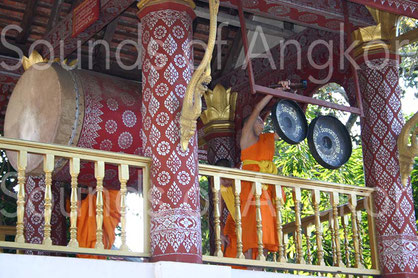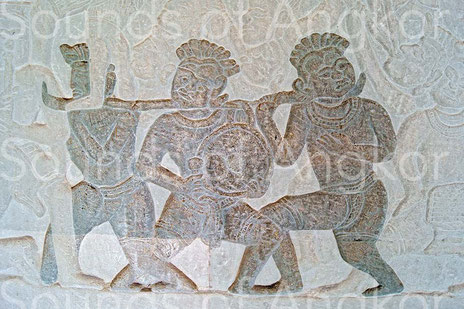Last update: December 5, 2023
As mentioned in the chapter about large drum or cymbals, there is no bossed gong iconography before the 16th century’s bas-reliefs of the north gallery of Angkor Wat or the frescoes of its central tower.

Epigraphy and translations
Saveros Pou, in her dictionary of Old French-English Khmer, mentions in connection with the word tāla: 'We used to translate this word by ‘cymbals’ according to Sanskrit. However, everything refers to ‘gongs’ of different types, made of bronze, copper or brass. (...) the gong accompanied the recitation of the chand poems.
But what does the word ‘all’ embody in this assertion?' The iconography, whatever its era, shows no gong, only cymbals. In India or Nepal, bhajan devotional songs are only punctuated by cymbals when there are no other musicians available. Cymbals are the ultimate rhythmic instrument during pre-Angkorian and Angkorian periods. If one refers to ethnology linked to Hinduism and Buddhism, when gongs are used, it is rather as a means of distant communication in order to call monks or devotees.
Bossed gong alive

In the north gallery of Angkor Wat, one can see several carried bossed gongs. In only one case, the protuberance does not appear in the sculpture, but color traces and scratches make it guess. A
single or a pair of gongs of different sizes are hang on the support. Moreover, while the drums on the support are hang by a single point, the gongs are always suspended by two.
Today, in Laos, these combinations are still known in the Buddhist pagodas: a large drum, one or two bossed gongs and sometimes a pair of cymbals invite the monks to gather for prayer on special
occasions or for the new moon.
Playing technique

Single or coupled gongs are struck with one or two spherical mallets by a single musician standing or sitting on the ground. This can be clearly seen on iconography; playing is quiet compared to that, fiery, deployed on the drums. In figure xxx the musician strikes with his right hand and stifles the sound of the left one, a technique well known among ethnic minorities in Ratanakiri and on most Indonesian bronze keyboards. The position of the left hand is thus accurately represented.

